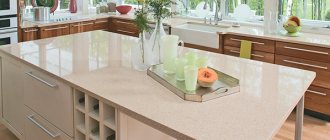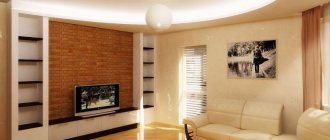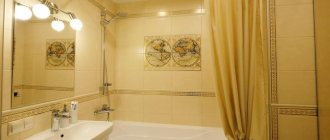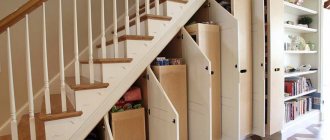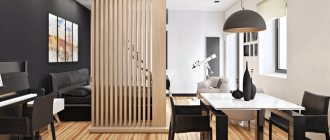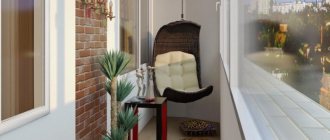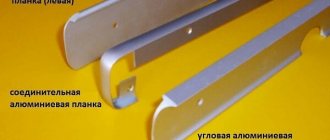No kitchen can do without a countertop, as this detail of the kitchen interior performs a number of important functions:
- is a work surface for cutting food and preparing it;
- is an area for placing the necessary equipment and tools;
- sometimes a tabletop can be used instead of a table.
Restoration of a veneered kitchen table top
The kitchen countertop tends to wear out over time; various chips may appear, since it is subjected to numerous mechanical influences and loads for a long time.
Partial restoration of a burn on a kitchen countertop before and after
Therefore, it is restored, updated and repaired more often than other furniture components of the kitchen in order to restore its attractive appearance.
A chipboard tabletop has a low price, as well as a large selection of a wide variety of colors and textures
These elements of kitchen furniture are made from various materials: wood, chipboard, stone, plastic, glass.
hpl panels for chipboard cladding have a huge number of color options and attract buyers at an affordable price
The most common type are those made from chipboard, as they are inexpensive and can withstand high temperatures. As an option, there are separate matte and glossy ones, coated with plastic. For their production, laminated, melamine and laminated chipboard is used.
Laminated chipboard - the sheet is covered with paper impregnated with resin
For laminated chipboard, the same paper is used, but of greater thickness, impregnated with melamine resin and fixed under pressure
The tabletop can be damaged due to exposure to moisture and heat, excessive looseness and other damage appear on it. Many people wonder how to repair a kitchen countertop.
Chipboard covered with film is afraid of moisture; the ends and edges of the tabletop suffer from water ingress
Ceramic tiles or mosaics are often used to restore the worn surface of a kitchen table.
Very often, countertop repairs can be done independently without the use of special tools.
Restoration of a table top made of chipboard before and after
Deep cracks
The most important thing here is not to leave the crack empty. In this case, it is best to adhere to certain rules:
- The crack must be protected from dust and dirt.
- Use wood putty to fill the damaged area.
- In the case where the surface is covered with paint or varnish, it must be cleaned with sandpaper.
- You can use stain to give the desired shade.
When the apartment contains very expensive or perhaps exclusive furniture, it is worth turning to professionals. They will help correct all defects without side effects.
PVA glue
Acetate glue, which contains natural substances, does a good job of sealing cracks in fiber boards. To do this, fill a syringe with it and inject it deep into the cleft using a needle. The glue must be applied carefully and strictly to the crack so that lumps do not form. After this, the part is tightened with clamps and waited until completely dry.
Oddly enough, this rich egg sauce can work real miracles. Of course, if the crack is not through. Mayonnaise is applied carefully and only to the crack itself, without affecting the surrounding areas, otherwise you will also have to get rid of greasy stains later. The composition is left on the problem area overnight, and the excess is polished with a soft cloth. If necessary, the remaining scratch or unevenness is masked with furniture wax or other suitable material.
Whichever method you choose, remember that it is better to first try it on an inconspicuous area, such as the inside of a countertop or drawer. This way you will definitely save your family budget from additional expenses, and yourself from unnecessary hassle and running around in search of new concealers.
When wiping dust from wooden furniture, it is difficult not to notice cracks, scratches, and abrasions. All these are integral companions of time, appearing in the process of using furniture. Even small errors on the surface are clearly visible. They spoil the perfect appearance of a varnished product and leave an unpleasant aftertaste.
Scratches and chips on wooden furniture or doors are a common problem encountered in almost every home.
You can treat the furniture with a mixture of vinegar and olive oil, using it as a polish, and then wipe it dry
Wood stain can help, as it is the best way to remove scratches on furniture.
While minor damage can be easily removed using home methods, masking deep defects requires the use of only professional products. In particular, putties. Puttying will allow you to achieve a uniform, clean, even coating.
The putty is carried out in two stages - first the main chip is repaired, and after drying the finishing layer is applied, with a slight excess
Preparing the site
Before starting work, you need to thoroughly clean the surface of the furniture from dust and dirt. The cleaned area is coated with a degreasing agent and allowed to dry. Also at the preparation stage, you need to decide what material will be used to hide defects.
Applying the material
The purchased material is applied with a suitable tool or cotton pad to the damaged area. When applying, try to ensure uniformity. Excess material is carefully removed with a spatula.
Painting
A layer of paint is applied on top of the applied masking material, which matches the color of the rest of the furniture. Paint not only visually hides defects, but also provides additional protection against new damage.
Installation
Or it becomes unusable over time and requires replacement. There is no need to be afraid of such work - it is quite within the capabilities of the most ordinary people. All that is required is sealant and self-tapping screws of a certain cross-section. Only in some cases, when there are no holes in the tabletop itself, either at all, or in those very necessary places, it is necessary to drill it. One way or another, after making sure that all the required holes are ready, apply sealant; Then all that remains is to screw the product with self-tapping screws and calmly use it.
Drilling artificial or natural stone is done with a drill at the lowest speed.
Types and installation of planks in the video below.
Restoration of wooden surfaces
No matter how carefully you handle the furniture, abrasions, scratches, and stains still appear. They are easy to eliminate. The main thing is to know how and with what.
- If the wooden surface has simply lost its shine, find a wood care product that contains orange oil. Take a clean sponge, dampen it slightly and microwave for 20-30 seconds. Spray the product from a spray bottle, then wipe with a hot sponge (hands should be wearing rubber gloves with a coating on the inside).
- More serious stains require serious measures. These are retouching markers (available in furniture stores), denatured alcohol and wax. First, clean the surface (dishwashing detergent diluted in water is the best solution). After cleaning, dry the wood with alcohol: use a moistened swab to rub the lightened areas well. In most cases, the color is restored. In deep scratches, alcohol does not restore the color; they are painted over with a marker of a suitable color. To add shine, the top surface is covered with wax and polished with a soft cloth.
- If you need to smooth out small unevenness, you can use a nail file. For meticulous work, it is easier to use than sandpaper.
- If the wood is locally swollen from moisture: place a leaking vessel, you can quickly get rid of the defect and neutralize its consequences by mixing salt and olive oil. The paste is applied to the damage and rubbed in a circular motion. Leave for 20-30 minutes. The salt will draw out the water, and the olive oil will restore elasticity to the fibers.
- If there are chips, you cannot do without putty. Suitable for both wood and automotive applications. The best way is to buy a light one and add color to it as needed. The chip is covered, a little putty is spread on the adjacent surface. After drying, everything is smoothed out well with fine-grain sandpaper.
If there are scuffs or stains on the wood, you can try to get rid of them by rubbing it with a banana skin. It works well for minor injuries.
You might be interested in reading what types of wall shelves there are (with drawings).
Melamine tape
The cheapest and most accessible way to improve edges. Does not require the purchase of glue or specialized tools. Everything you need can be found in any household, and the process will take a few minutes.
The edge processed in this way looks very neat.
Should be used for finishing hard-to-reach edges of table tops. At the same time, do not forget about dampness, which will penetrate under the edge and destroy the material.
The gluing technology looks quite simple.
- Turn on and heat up the iron. Select the temperature so that the paper base of the material and glue do not burn.
- Cut the tape 2 cm longer than the edge to be processed.
- Attach the melamine strip to the end of the tabletop with the side on which the adhesive is applied.
Therefore, at this stage it is important to align it along one edge, as in the photo.
The iron should not burn the edge, but should well melt the glue that is applied to its reverse side.
Do not use a sharp knife, it will cut off the edges of the material and ruin the whole look.
Use a soft cloth with solvent to gently wipe the finished edge of the tabletop.
Principles and instructions for restoring chips on a countertop
Knowing how and what you can use to repair a chip or crack on a tabletop, it’s not difficult to repair the furniture structure yourself
At the same time, it is important to comply with technological requirements and use effective options for restoration compositions
Restoration of wood and laminated chipboard countertops
When solving the problem of how to repair a chip on a chipboard tabletop, repair work involves the following algorithm:
- use a hairdryer to warm up the damaged area;
- remove the exfoliated layer, clean the defect area;
- apply glue and leave for 15 minutes;
- prepare the restoring composition in the form of a homogeneous thick mixture of sawdust and PVA glue, leave for 10 minutes;
- the damaged area is sealed with the prepared mixture, the mixture is compacted with a spatula, and the excess is removed.
Restoring a wooden countertop takes at least 24 hours
At least 24 hours are required for complete drying, after which the repaired particle board material is ready for use.
To disguise scratches on a wooden countertop, you should sand the surface and sand it. At the final stage, felt is used to provide a glossy finish. To eliminate chips on a wooden base, mix sawdust and PVA glue and fill the voids, which are first cleaned, blow-dried and sanded.
Plastic countertop repair
Deciding how and with what to repair cracks and chips on a plastic countertop in the kitchen should depend on the complexity of the deformation:
- minor damage to the plastic surface can be repaired using superglue or Moment glue;
- in some cases, restoration of the working plane requires the use of special glue for plastic. The composition is applied using a gun;
- If a fragment of a plastic structure breaks off, Titan glue is used for restoration.
To restore chips, it is recommended to grind the plastic into crumbs or powder, mix well with Titan glue and repair the damaged areas of the structure.
Restoring an artificial stone countertop
Cracks and chips on the working surface made of artificial stone are repaired using polyester resins. The algorithm of restoration procedures includes the following manipulations:
- the damaged area is cleaned and degreased;
- if necessary, the chip site is slightly deepened and widened;
- seal the defects with polyester resin and leave to dry completely for a day.
Next, you need to sand the coating with fine sandpaper, followed by polishing with felt. Small scratches on artificial stone can be easily masked with a repair acrylic compound or a glossy solution. I’m planning how to remove a chip on a stone countertop in the kitchen, using PVA glue, abrasive material of different grain sizes and felt.
- prepare the surface by sanding and grinding the damaged areas;
- prepare a restorative composition from acrylic plastic with the addition of an adhesive mass to a thick, uniform consistency;
- The restoration mixture is used to seal the depressions, chips, cracks and leave until complete polymerization;
- Next, the coating is polished with an abrasive material; at the final stage, it is necessary to polish the surface with felt.
Restoring an artificial stone countertop
Stone countertops with minor defects are often repaired using a grinding machine.
To do this, at the first stage, grind and polish the base; this will help to easily eliminate traces of careless use of the working surface. Next, the material is treated with special reducing solutions. Then they go through the grinding unit again: first with an abrasive, and then with a polishing disc.
At the same time, small cracks and chips are eliminated, the stone base acquires an aesthetic appearance and presentability
Then they go through the grinding unit again: first with an abrasive, and then with a polishing disc. At the same time, small cracks and chips are eliminated, the stone base acquires an aesthetic appearance and presentability.
The nuances of glass countertop repair
A kitchen countertop made of glass is difficult to restore, so care and attention are required when using it. Special equipment is used to remove small scratches. This requires skill and skills in working with fragile materials.
If, as a result of careless handling, defects in the form of cracks or chips have formed on the surface, the structure will have to be replaced with a new one, since it will be difficult and expensive to restore the integrity of the glass tabletop
Kinds
A very important role is played by the protective strip of the dishwasher - the same one that is also a sink. Thanks to it, moisture and dirt do not get inside the cut in the form of:
- drops;
- splash;
- condensate;
- fat;
- water vapor;
- cuts of meat, vegetables.
The corner model is used mainly where it is necessary to connect the elements of the tabletop itself. Basically, such products are produced on the basis of aluminum alloys. This guarantees:
- high strength;
- easy cleaning;
- attractive decorative properties of metal surfaces;
- versatility of colors, perfectly combined with a variety of tones in the design;
- resistance to temperature fluctuations and humidity (for a steel model such corrosion resistance is difficult to achieve).
The slot strip in most cases belongs to the already mentioned protective category. Please note: such products may also be called docking or connecting strips. There are no strict standards here. The overlay structure can also play a protective role, but one must understand that it is only suitable for straight surfaces. There are also rear and front, wide and narrow, front and side, T-shaped and U-shaped, right and left plank structures.
The difference may also apply to the base material. Of course, wood and ferrous metal are not used. However, the already mentioned aluminum and stainless steel have serious competitors. In some cases, the bar is improvisedly replaced with a thick silicone strip. This is a practical, but not very attractive solution.
Repair of laminated chipboard furniture
Serious repairs to laminated chipboard furniture frames are required in cases where hinges, guides, fasteners and fittings are torn out of the board due to excessive load or improper use. Let's consider various options for restoring buildings.
Restoration of holes for fasteners
Laminated chipboard is a fairly durable material, but as long as its integrity is not compromised. Due to loads, improper operation, periodic disassembly of furniture or frequent opening of facades, holes very often break, as a result of which screws, confirmations, hinges and other fittings fall out of their fastening points. Simply screwing the fastener into the same place will not work, since the diameter of the hole has increased. However, there is one method that furniture assemblers use.
In order to be able to screw a screw or confirmation into the old place, you need to proceed as follows:
- use a drill with a diameter of 8 mm to expand the existing hole;
- pour PVA or wood glue inside;
- drive a wooden wedge or “coke” into the hole and cut off the excess;
- make a hole in the “coke” with a diameter smaller than that of a self-tapping screw or confirmat;
- screw the hardware into place.
Now you can install the hinge mounting and adjustment pad
How to repair a broken furniture hinge
It happens that a furniture hinge on the facade itself is pulled out of its seat along with pieces of laminated chipboard or MDF. The simplest option is to completely replace the module door. But the façade material may differ slightly in shade from the rest of the structure, and the cost of such repairs may be high. You can repair the canvas and install the hinge yourself and at minimal cost. There are two options:
- Moving hinges above or below the original installation location.
- Repair of the hinge seat.
The first option is the simplest and fastest, but you will still have to seal the old holes. To disguise a broken seat, you can use a special plastic plug. Large holes are restored using PVA mixed with fine sawdust. After the mixture has dried, it is masked with wax pencils and polished.
Moving the loop to another location
The second option is more complex, but, nevertheless, it will avoid making new holes and will extend the life of the facade for several more years. To restore the hinge seat you will need:
- epoxy resin;
- small sawdust;
- rubber or plastic spatula;
- electric drill;
- loop cutter.
Loop torn from the façade with “meat”
First of all, you need to clear the seat of the torn loop, mix sawdust with epoxy resin and fill the recess, leveling the mixture with a spatula. Allow to dry and, if necessary, add more filler. After complete drying, sand the hinge installation area. Next, make markings and, using a cutter or electric drill, drill a groove of the required depth for the mount.
Prepare a mixture of sawdust and epoxy resin and fill the seat of the furniture hinge bowl
Reinstall the hinges
A simple but dubious method
There is another way to attach a torn loop, but it is quite dubious, both from an aesthetic and practical point of view. A wooden block or plywood strip is installed in place of the hinge using glue or self-tapping screws. The fastening for the facade is mounted on them. The plank or block is fixed using screws or glue. However, with this method of installing the hinge, the facade can move significantly relative to its original position, and no adjustment can correct this.
For your information! In order for facades to last for a long time, you need to follow a few simple recommendations. It is necessary to tear off the doors of cabinets and bedside tables smoothly, without sudden movements. Do not hang heavy objects on the handles of the facades, as this leads to increased load, distortion and tearing of the hinges from the landing sites.
From the author
The background to the work described in this article is as follows. For the kitchen, a 2400 mm long kitchen worktop was ordered. Since the tabletop is sold in 3000 mm pieces, the manufacturer received a completely finished tabletop 2.40 cm long and the remainder of the tabletop 60 cm. It was this remainder that had to be glued to the edge of the tabletop.
Installing a countertop is a complex and time-consuming job that requires special tools and practical skills. Installing a countertop without practicing such work is almost impossible. Therefore, I recommend that if you do not have similar work experience, you invite professionals to install the countertops. The craftsmen of the company santex-mastera.ru, who can be invited on the website https://www.santex-mastera.ru/, will carry out professional installation of the countertops, using modern tools and linking them to your kitchen furniture.
Restoration of chipboard furniture: what you might need
- Soft furniture wax (wax putty). Used to seal chips, scratches, cracks on wooden and laminated surfaces of cabinet furniture, interior doors, laminate and parquet. Provides moisture resistance to the restored surface.
- Hard furniture wax (melt putty). Requires melting before use (for example, using a lighter, soldering iron or gas torch). Application is similar to soft furniture wax. Recommended for restoration of chipboard surfaces with high intensity of use (countertops, shelves, floor coverings).
- Retouching agents - felt-tip pens or alcohol-based markers, valve and fiber. With their help, the texture of the material at the restoration site after waxing is completed to make it less noticeable. Ordinary felt-tip pens in shades that match the furniture, strokes, paints, even shoe polish and iodine will also work.
- Fixing varnishes, polishes (best in the form of sprays and aerosols) for surface treatment after restoration. For coating after restoration of defects, returning surfaces to their former shine, masking abrasions and minor scratches.
- Melamine edging with adhesive for replacement trim.
- Two-component epoxy composition, PVA, dowels (chops), wooden plugs for filling holes from torn hinges and other fasteners.
- Tools – plastic spatula, sandpaper, abrasive sanding sponge (fine), utility knife, hair dryer or iron, chisel, non-woven wipes and rags for finishing.
Melamine tape
The cheapest and most accessible way to improve edges. Does not require the purchase of glue or specialized tools. Everything you need can be found in any household, and the process will take a few minutes.
The edge processed in this way looks very neat.
Should be used for finishing hard-to-reach edges of table tops. At the same time, do not forget about dampness, which will penetrate under the edge and destroy the material.
The gluing technology looks quite simple.
- Turn on and heat up the iron. Select the temperature so that the paper base of the material and glue do not burn.
- Cut the tape 2 cm longer than the edge to be processed.
- Attach the melamine strip to the end of the tabletop with the side on which the adhesive is applied.
Therefore, at this stage it is important to align it along one edge, as in the photo.
Restoration of faded and worn chipboard countertops
Often, during use, chipboard countertops and cabinet covers wear out.
A tabletop that has faded from abrasion without severe defects on the surface (deep scratches, cracks) can be restored as follows:
- Select the coloring agent according to its shade. It is best to use felt-tip pens - you can moisten a rag with them and rub in soft circular motions and walk across the tabletop until it acquires an even color. Then fix the tint with a fixing varnish.
- In some cases, it is enough to treat a chipboard tabletop with polishing mastic with pigment (available for sale for light and dark furniture) or polish for laminated furniture. After applying the product, the surface must be polished with special lint-free wipes.
Choice
But limiting ourselves to size alone is not everything.
In order for the plank for the end of the tabletop to fulfill its function clearly, you need to pay attention to other subtleties. So, along with aluminum products, plastic structures can sometimes be used
But they are not durable enough and are easily damaged by sharp objects, so you can choose such models only as a last resort when there is an acute shortage of funds. Metal structures should ideally have a matte appearance so that any roughness is less noticeable; Otherwise, it is enough to consult with sellers or countertop manufacturers.
How to Repair Worn and Broken Furniture Parts
First of all, you need to know: cracked and damaged furniture is repaired immediately after the defect is discovered. Otherwise, the pins and tenons may become deformed at the joints and it will be much more difficult to repair the furniture. So don’t debug for later, especially since fixing shortcomings is not particularly difficult. If you notice that some furniture parts are not connected tightly to each other, then you can start repairing. For this purpose, the future gluing area must be cleaned of old glue. This can be done using sandpaper. Afterwards, they need to be lubricated with casein, carpentry or PVA glue, squeezed tightly with a clamp, tied with twine and pulled as tightly as possible using wooden wedges. It would also be a good idea to put some kind of weight on the parts to be glued, so they will stick better. If, after cleaning the tenons, gaps appear at the joints, it is necessary to drive thin wooden wedges into them, pre-lubricated with glue. Small gaps can be eliminated using a cloth soaked in glue or putty.
In a stool with a cast metal frame, the thread breaks off in the socket where the leg is screwed in. We fix it as follows: take a nut with an identical thread and grind off the end, leaving two protrusions. In the hole with a deformed thread, we make two cuts for the nut protrusions using a needle file, and in the seat you need to select a recess for it. Next, we tighten the nut and screw in the leg.
Loose chairs with braces in the structure connecting the frame can also be repaired. To do this, holes are drilled: in the legs of small depth, and in the struts - through. Then you need to screw in the screws until the legs and struts are pulled together.
Furniture made from chipboard sometimes makes you happy with doors that fall off. This is due to poor fastening of the screws on the walls. In this case, you need to carefully drill holes for the screw (diameter 8 mm), drive a wooden plug into it (previously coated with glue) and screw the screw into it.
By the way, when drilling a polished slab, it is better to wrap the drill in a felt washer. This will protect the surface from damage, even if the drill goes right through.
Characteristic
A countertop plank is a product that is responsible for the aesthetic characteristics of the structure as a whole, for its visual perception. And it’s not worth separating even such a seemingly abstract moment as the coloring of the plank from the tonality of the main element. Traditionally, lunch in the kitchen is usually spent at a table with a white or very light profile. There is absolutely no point in challenging this old, time-tested practice. But there are times when only professional designers can make the right decision.
Often the color is selected taking into account the colors of the lower hanging or floor cabinets. But the opposite solution is often practiced (with the task of conscious contrast).
They are valued for their visual luxury and sense of good taste.
What is important is that such effects are achieved very simply and without any significant additional effort.
But you should think about choosing this or that color later, but for now it’s useful to go back a little and figure out what the design itself is. A universal sealing block is in demand because the tabletop is continuously exposed to intense mechanical (and other) influence. And apartments often lack the basic production length of countertops, which is 3-4 m. Of course, they are extended, but the places where they are extended are always subject to destruction, and this will be confirmed by any engineer or a person who simply understands physics. The flexible wall profile solves the same problem as the front edge material, but its placement is somewhat different, as the name already says.
Restoration of chips and scratches
At the ends and surfaces of countertops, especially at corners and radii, chips are not uncommon. They can be easily removed, especially if a melamine edge was used when processing the ends. For restoration, you will need to purchase new material for processing edges, preferably PVC, of the required length and color, from a specialized store that sells chipboard and furniture fittings. Using an iron or an industrial hair dryer, remove the old edge, clean the chipboard from chips with sandpaper and, while also warming it up, stick on a new one. Cut off excess edges with a utility knife and sand with fine-grained abrasive paper. Often, after installing the edge, traces of glue remain. They can be disguised with tinting.
Restoration of a dent on the end of the facade
If the chips, scratches and dents on the furniture are quite deep, they can be disguised as follows:
- Treat the defect, clean it from dirt and, using a chisel, give the recess a more or less rectangular shape.
- Choose furniture wax to match the chipboard. Sometimes you need to mix several different crayons to find the right shade, since you are unlikely to find the desired color in a pure color.
- Using a rubber spatula and softened wax, fill the recess and compact well.
- After the wax has hardened, you need to carefully cut off the excess using a utility knife or rubber spatula. The wax should be flush with the surface of the chipboard.
- Sand and polish the wax with a rag. If necessary, use retouching agents to restore the texture of the material. The final step will be to fix the result with a fixing varnish.
Filled scratches mask and highlight texture
Related article:
How to remove scratches from furniture using: furniture pencil and stroke, wood wax and mastic, oil polish, using walnut kernels, nut oil, mayonnaise, tea leaves, machine oil, iodine, vinegar with vegetable oil, stain - in our publications.
What are they?
In the assortment of modern manufacturers, corner profiles play an important role. Of course, they are used to connect parts of the tabletop mechanically end-to-end at a certain angle. The name “docking” is usually assigned to an element that is mounted at a right angle and plays an increased decorative role. The end product covers the initially uninsulated end and prevents negative impacts on it from the external environment. The thickness and radius of a particular option always play a key role in selection.
But it is always necessary to clarify what exactly the manufacturer or supplier means by a certain item in the catalogue/contract, receipt or price tag (label). So, slotted strips are just an alternative name for connecting profiles. It’s just that the terminology in this area is not yet well established, and one cannot count on uniformity of names. Another example is that the concepts of wide and narrow bars have little to say to the consumer.
The T-shaped model has an important specific feature - it ensures the most accurate and careful connection of the parts of the tabletop. Even if these parts are very heterogeneous in terms of geometry and mechanical qualities, the creation of an integral composition is guaranteed
Most often, profiles are made from aluminum alloys, since this particular substance - not ferrous metal, not plastic or stainless steel - has a number of important advantages:
- chemical inertness;
- ease;
- strength;
- reliability;
- pleasant appearance;
- resistance to high and low temperatures, water vapor, fats and organic acids;
- hypoallergenic.
A very relevant characteristic is the size of a specific bar. You can often find designs with a thickness of 26 or 38 mm. Such products in many cases have a length of 600 mm - and this size ratio was chosen by engineers based on familiarity with the practice of use and reviews.
But many companies are ready to offer profiles of other sizes. Thus, planks with a thickness of 28 mm are regularly found in the catalogs of furniture companies. These can be simple connecting, end, and corner structures. But models with a size of 42 mm usually need to be ordered additionally - they are a rarity in manufacturers' catalogs. However, with the modern variety of furniture workshops, this, of course, is not a problem.
What is important is that a rounded bar, regardless of its dimensions, is the safest. This property will be most appreciated by those who have small children at home.
However, even for the most brutal adults, an unnecessary collision with a sharp angle is unlikely to evoke positive emotions.
Finally, it is worth considering the topic of painting the connecting strips. Like the countertops themselves, in most cases they are black or white. But the choice of users naturally does not stop there.
Thus, in interiors that are neutral in spirit, many users consider a beige tone to be the best solution. It perfectly suits the “kitchen” mood and does not excite the nerves too much. Sand color is suitable for rooms with light wooden facades. It is also good where the design is different, but there is a lot of light.
Other main options:
- metallic - for practical people who love to cook in their kitchen;
- dark brown color - an expressive rich contrast in a very light interior;
- green (including both herbal and light green) is an excellent choice for romantics, for families with children, for those who are not used to being discouraged and upset;
- red - a bright accent against a white or moderately dark background;
- orange is an excellent combination with brown or other moderately saturated colors of furniture;
- pink - creates a spectacular and at the same time devoid of any aggression mood;
- oak - expresses traditionalism, solidity and respectability;
- A milky white shade is suitable for diluting a very dark-looking kitchen.
How to glue an edge to a tabletop?
There are two ways to glue the edge to the tabletop, that is, simply fixing the material with an already applied adhesive layer, and without it. In the second case, you need to purchase a universal type of adhesive that will hold the tape well with wood and plastic.
Let's consider which material is better to choose based on thickness. You can avoid finishing those areas that are invisible and save money, but it is better to do the work around the entire perimeter, protect the product from mechanical action, and protect yourself from the release of toxic substances.
To finish inconspicuous areas, you can use PVC tape, which has a thickness of 0.4 millimeters. On the front side, 2 mm tape is used for greater strength and aesthetics.
